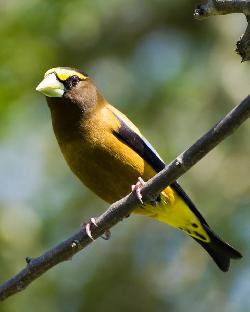
Courtesy Pixabay
(A Very Rare Bird in Logan. However reported to eBird in 2010, Ivins, UT.)
 Cache Valley (Logan) Utah Circle
Cache Valley (Logan) Utah Circle
December 16, 2023
124th Annual Christmas Bird Count
67th Local Bird Count
Visit BridgerlandAudubon.org
 Great Backyard Bird Count, Feb 16-19, 2024
Great Backyard Bird Count, Feb 16-19, 2024
Courtesy Cornell Lab of Ornithology & Bird Canada, Sponsors, GBBC. For more information visit BridgerlandAudubon.org
 Count Winter Feeder Birds for Science
Count Winter Feeder Birds for Science
Project FeederWatch
Short-eared Owl, Courtesy Project FeederWatch, Walt Cochran, Photographer
For more information visit BridgerlandAudubon.orgThe National Audubon Society invites novice and expert bird watchers to participate in the Annual Christmas Bird Count. This is an opportunity to contribute to a long-standing tradition of inviting everyone to play a role in Conservation by observing and counting birds.
The Christmas Bird Count is an annual 24 hour bird survey which takes place in pre-designated 15-mile diameter Watch Circles between December 14 and January 5. Participation is free, but pre-registration is required.
Dedicated bird lovers face the elements for a full day of trekking and observing along familiar routes, in organized teams, following mapping protocols and a daylong commitment, but anyone who lives inside a Watch Circle can stay cozy inside observing birds through the windows.
It’s important to remember that time spent watching is counted – the total effort is counted even if there are zero birds observed. And, if you think you spotted a rare bird, be sure to take photos for confirmation. Birds will linger longer where they can perch and shelter in trees and shrubs, and especially if they find treats such as Black Oil Sunflower Seeds, White Proso Millet, suet, and of course, fresh clean water!
Whether or not you live in or near a Christmas Bird Count Watch Circle, be sure to mark your calendar for the mid-February Great Backyard Bird Count, which is an easy event for everyone everywhere, and only requires participants to count birds in their own backyard for as little as 15 minutes (or as long as they wish).
In fact, when it comes to counting birds, every day can indeed be like Christmas, with the option to use the eBird smartphone app developed by the Cornell University Lab of Ornithology, allowing birdwatchers to log their data directly into a growing searchable database.
Audubon’s Christmas Bird Count is a prime example of how everyday observations from first-time volunteers and experts alike can make a big difference in understanding changing patterns in our world. One advantage of the staggered schedules is that you are welcome to participate in as many circles as you wish.
Find out more about watch circle events near you, including early morning Owling, and After School and pre-count Scouting Bird Walks. For more information visit BridgerlandAudubon.org, that’s Bridgerland A-U-D-U-B-O-N dot org.
I’m Hilary Shughart with the Bridgerland Audubon Society and I am Wild About Utah, and Wild About the roughly 100 species documented in our Annual Christmas Bird Count in Cache Valley since 1955!
Credits:
Images: Red Cardinal, Courtesy Pixabay
Cache Valley (Logan), Count Circle, Courtesy Bryan Dixon, 2015
Great Backyard Bird Count Courtesy BirdCount.org, Cornell Lab of Ornithology, National Audubon, and Birds Canada
FeederWatch Courtesy BirdCount.org, Cornell Lab of Ornithology and Birds Canada
Featured Audio: Courtesy & Copyright © Kevin Colver, https://wildstore.wildsanctuary.com/collections/special-collections/kevin-colver and Friend Weller, Utah Public Radio
Text: Hilary Shughart, President, Bridgerland Audubon Society
Additional Reading: Hilary Shughart and Lyle Bingham, https://bridgerlandaudubon.org/
Additional Reading
WildAboutUtah pieces by Hilary Shughart, https://wildaboututah.org/author/hilary-shughart/
Utah Birds list of Regional Christmas Bird Counts
Worldwide Christmas Bird Count Map, Zoom in to locate the closest to you, National Audubon, https://gis.audubon.org/christmasbirdcount/
Bridgerland Audubon CBC Toolkit https://bridgerlandaudubon.org/our-projects/cache-valley-christmas-bird-count/
National Audubon Data: Annual Summaries of the Christmas Bird Count, 1901-Present https://www.audubon.org/content/american-birds-annual-summary-christmas-bird-count
Tips from eBird on How to count large flocks of birds:
“Big numbers of Moving Birds. Their are two ways to count large flocks of moving birds: either by blocking off a group of individuals, counting them, and then extrapolating to the whole of the flock; or by counting birds per unit of time.”
Team eBird, Bird Counting 101, eBird is a project of the Cornell Lab of Ornithology, https://ebird.org/news/counting-101/
General Tips for Bird Identification:
Mayntz, Melissa, Bird Bill Parts, The Spruce, Updated on 08/01/22, https://www.thespruce.com/bird-bill-parts-387362
Project FeederWatch: November-April
Project FeederWatch Background on BridgerlandAudubon.org: https://bridgerlandaudubon.org/birding-tools/birding-events/project-feederwatch/
FeederWatch.org, the official site: https://www.feederwatch.org/
The Great Backyard BirdCount, February 16-19, 2024
GBBC Background on BridgerlandAudubon.org: https://bridgerlandaudubon.org/birding-tools/birding-events/great-backyard-bird-count/
BirdCount.org, the official site: https://www.birdcount.org/
eBird Resources
eBird Background & Reports on BridgerlandAudubon.org: https://bridgerlandaudubon.org/birding-tools/ebird/
eBird Resources: https://ebird.org/about/resources
eBird.org site: https://ebird.org/



